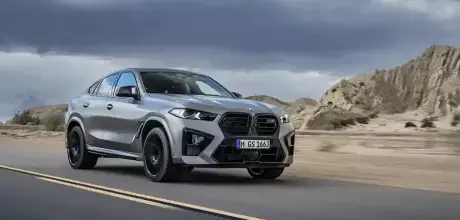2025 BMW X6 M Competition F96 LCI
The X5 and X6 updates have brought the big SUVs bang up to date, but have they made the high-performance X6 M Competition F96 more or less compelling?
F96 LCI X6M Competition
Words: James Fossdyke
Photos: BMW
First Drive: BMW F96 LCI X6 M Competition Massive and monstrously fast, the X6 M Competition has received its midlife facelift, so we take it for a spin.
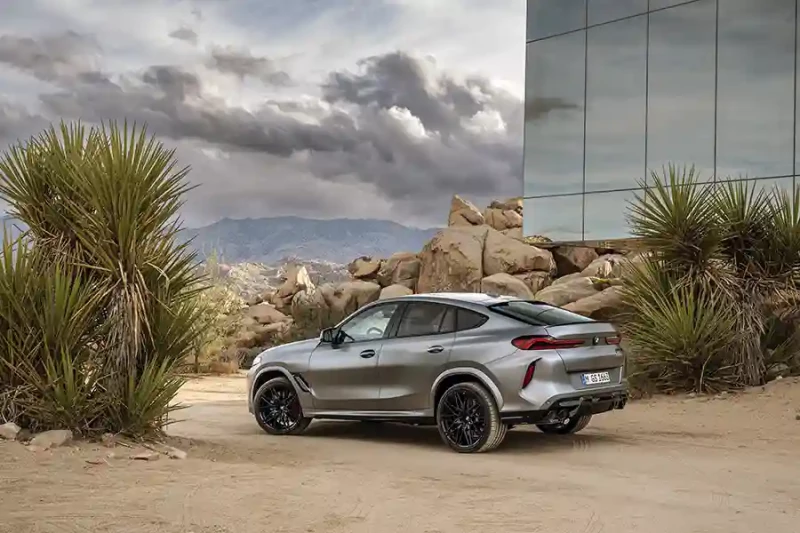
On the face of it, the 2025 BMW X6 M Competition F96 has never made much sense. If nothing else, it’s essentially a less practical version of an already fairly ridiculous car. The car in question is the X5 M Competition, which shoehorns a massive V8 and a bucketful of sporting intent into an enormous 4x4 for reasons that aren’t entirely clear. Yet, while the X6 and its more conventionally shaped sibling might feel a bit superfluous in the grand scheme of things, that has never stopped them from receiving our respect. Not because they make more sense than you think — they don’t, really — but because they're works of engineering genius to be celebrated like Concorde or the Burj Khalifa. The world doesn’t really need them, but the fact they exist — and, more than that, the fact they work — is something worthy of our admiration.
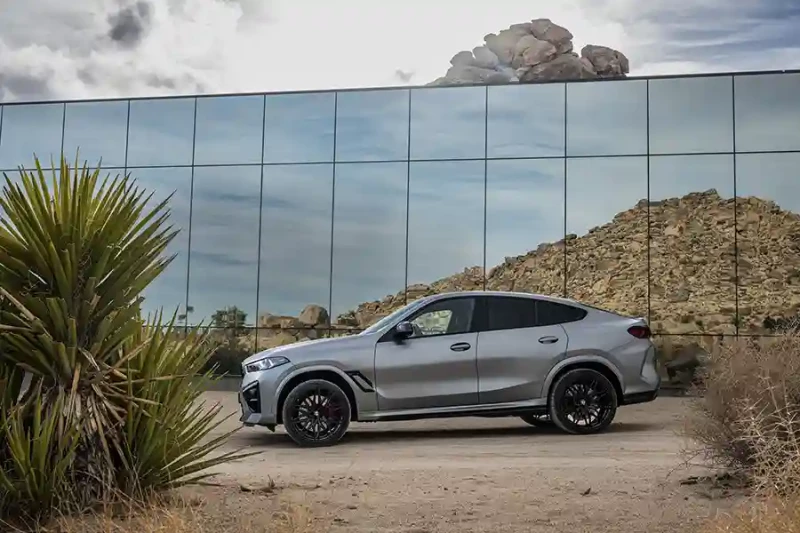
And now we find BMW has been hard at work ensuring the X6 M Competition is even more worthy of our respect with an updated version. A mid-life refresh doesn’t mean much in terms of performance per se, but the X6 now looks more interesting and gets some extra standard equipment, and the high-performance M Competition version has inherited those same upgrades. Most prominent is the new front end, complete with a revamped kidney grille and new headlights, which feature a kind of chevron light signature. Thankfully, BMW has resisted the urge to fit an enormous front end to its most powerful version of the X6, but a new grille-and-headlight combination is complemented by a glossy black fascia and a more aggressive front bumper than the standard car. And as with so many other M cars, BMW continues with the aerodynamically sculpted door mirror caps.
Unlike the X5, which received new rear lights as part of its refresh, no version of the X6 has had the same update, with BMW preferring to stick with much the same rear-end as before. The X6 M Competition still gets a sportier rear bumper and massive exhausts, as well as more glossy black trim in the shape of that rear diffuser-style insert. Add in massive alloy wheels (21” at the front and 22” at the rear) that barely mask the updated braking system with its red calipers – and a little lip spoiler on the tailgate – and you’ve got an altogether sportier look than the conventional X6, and indeed the X5 on which it’s based.
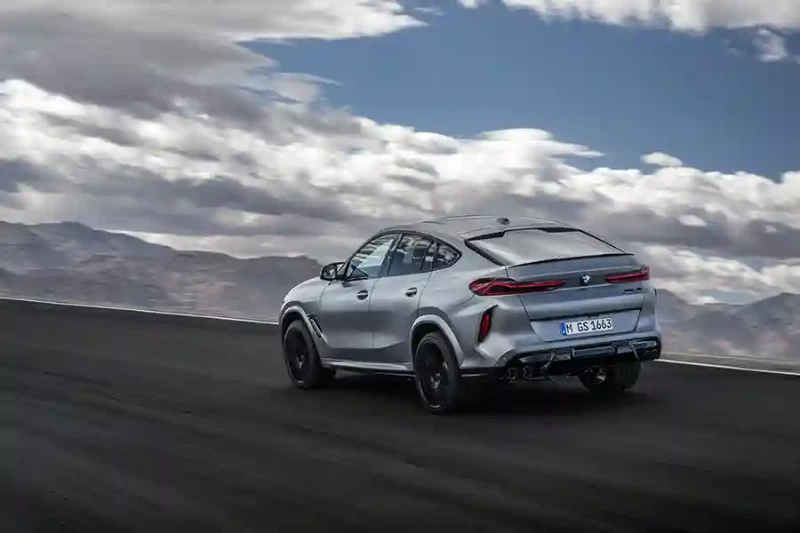
That’s partly down to the more rakish rear windscreen, which is carried over from the old X6, but there’s more to it than that. The whole car looks lower, squatter and stronger as a result, giving it a sportier image than even the X5 M Competition with which it shares so much. With its slightly more upright design, the X5 just doesn’t look quite so purposeful.
Therein lies the main appeal of the X6 over its sibling – at least in theory – and it’ll be the differentiator for a lot of customers. However, those who choose the X6 over its sibling won’t feel too disappointed by the sacrifices they have to make for that more aggressive look. Although the roofline is lower than that of the X5 M Competition – the X5 is about 60mm taller in total – the X6 still has more than enough headroom to accommodate four reasonably tall adults in comfort. Yes, someone over the height of six feet will find their head a little closer to the black roof lining than they would in an X5, but they still won’t be smacking their scalp against the roof lining when you go over a bump.

Legroom is more than sufficient, too, and boot space is still respectable, if not quite as generous as the 650-litre space you’ll find in the back of an X5 M Competition. Still, at 549 litres, it’s more than enough for most people’s requirements, although you will need to take the angle of the rear window into account when loading bulkier items if you want to avoid an embarrassing and expensive chat with the people from Autoglass.
And while there are slight differences between the space available in the back of the X6 and its SUV-shaped sibling, the driver and front-seat passenger will barely notice. Yes, rear visibility is noticeably more limited, but aside from that, the view is much the same. Like the X5, the X6 gets the new Curved Display that incorporates both the new touchscreen infotainment system and the digital instrument display in one clean housing. It’s nothing new these days – BMW has already employed it in the new 3 Series, the iX electric SUV and numerous other models – but that doesn’t stop it from being a cracking system. The screens are clearer, sharper and more colourful than before, adding an air of modernity to proceedings, and the response from the system is equally crisp. Navigating is made easy, not only by the logical menu layouts but also by the inclusion of the iDrive rotary controller on the centre console. BMW has removed it in some of its smaller models, but keeping it in situ in the X6 allows you to maintain a bit more concentration on the road ahead when you’re driving.
And while much of the attention will undoubtedly be lavished on the central screen, we’d like to heap the same praise on the digital instrument displays included with BMW’s latest Operating System 8.5 technology. Whereas the old X6’s cabin had a cluttered and less configurable instrument display, the new system offers drivers much more choice of what they see and a much less confusing way of viewing it. But there’s more to the addition of the new Curved Display than the displays themselves. The system incorporates a touchscreen climate control interface that’s a little more fiddly than conventional switchgear, but it has allowed BMW to clean up the dashboard for a more modern feel, including clever ambient lighting that will change when you receive a phone call, although that feels like quite the gimmick.
All that said, there’s no real difference (aside from a few touchscreen and instrument cluster displays) between the tech in the X6 M Competition and that of lowlier models. But there is quite a difference in the design of the cabin. For example, where less upmarket cars – including the M60i xDrive that’s supposed to have some of the M car’s styling – have a toggle-style gear selector integrated into the centre console, the M Competition gets a more conventional gear lever with a sporty, skeletal design and BMW M stitching. Sporty seats and red switchgear add to the look, with the now-familiar vehicle set-up buttons found on other M models and, indeed, the last X6 M Competition. That is also teamed with glossy black dashboard trim and an M design in the aforementioned ambient lighting system, all of which help to raise the mood a little. But this is still a car with sporting intentions, and the overall theme is pretty dark, particularly if you opt for the black leather.
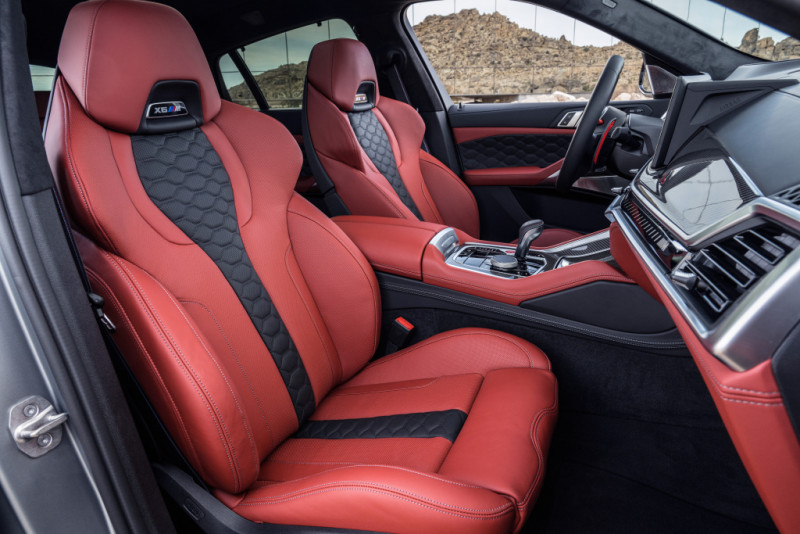
Fortunately, the X6 M Competition can back up that sportiness, with a more or less unchanged 4.4-litre engine block hiding behind that new-look grille. Producing 626hp and 553lb ft of torque, the twin-turbocharged engine powers all four wheels via an eight-speed automatic gearbox, and it gives even the 2.45-tonne X6 M Competition enough grunt to get from 0-62mph in 3.9 seconds. That’s the same performance you get from the X5 M Competition, and it’s still fast enough to give most sports cars a run for their money.
The sound is decidedly sporty, too, although that BMW V8 feels slightly more muted than similarly powerful engines from other manufacturers. Even so, in their sportiest settings, the engine and exhaust combine to provide quite a sophisticated rumble, punctuated by the occasional snort from the exhaust during gear changes. It might not quite have the sharpness of some other SUVs, but it sounds slightly more purposeful in the M Competition than it does in the M60i xDrive, which is designed to sit somewhere between the more mundane X6 variants and this range-topping M Competition version.
Although it’s true those figures mean the X6 is no faster than the X5 M Competition, the X6 claws some kudos back in other areas. For one, it handles better, with a lower centre of gravity that ensures it rolls less dramatically in corners. In fact, the whole car feels pretty much level unless you really push the limits, with sportier settings trading off body control for a bit of ride comfort. However, with such good steering, even in Comfort mode, the X6 M Competition is always rather fun in the corners. There’s no masking the size of the beast – it’ll always be huge, and there’s no getting around that – but it’s surprisingly agile for something so massive. It’s the sort of agility, in fact, which makes you wonder how well it could cope on a racetrack, as opposed to the open road. Not that there’s any point in trying that.
And there’s more than enough fun to be had on a conventional road. But while other X6s are merely very impressive, the M Competition adds a bit of extra bite, with that fraction of extra agility, that mite more eagerness to turn into corners and the body’s marginally more rapid response to the actions of the front wheels. It’ll give plenty of hot hatchbacks a run for their money.
While the BMW X6 Competition’s talents are obvious, it does have drawbacks. For one, the ride is a little more brittle than it is in other versions of the X5 and X6, thanks in no small part to the massive wheels and the M-specific suspension that gives the car such good body control. It isn’t unforgiving or rigid in the way some sporty SUVs might be, even in sportier settings, but it never quite settles on most surfaces either, with a slightly bubbly feeling from the rear end. It isn’t disastrous by any measure – most passengers probably won’t even notice, and it improves at fast motorway cruising speeds – but it makes the car feel that tad more nervous than it should.
But the bigger issue is one of price. BMW is charging £129,550 for an X6 M Competition, and that’s about £35,000 more than you’ll spend on an M60i xDrive with much the same engine. Sure, the supposedly lesser car is about 96hp down on the M Competition, but the 0-62mph sprint is dispatched almost as quickly and you won’t really notice the shortfall in performance on the road. Nor will you notice the difference in specification too much. Both cars get everything you really need, including navigation systems, climate control and leather upholstery, as well as sporty styling and plenty of other toys, including manoeuvring cameras and an electrically operated tailgate.
Even with ample equipment, that lofty price makes it difficult to describe the X6 M Competition as good value, although the market is swimming with capable SUVs that cost more but deliver little extra. The problem, though, is not how this topend variant stacks up compared with its rivals, but the way it stacks up compared with other versions of the X5 and X6. An M60i xDrive offers almost as much capability with the tiniest whisker of extra comfort, and it costs about £30,000 less. Perhaps that won’t matter too much to those who have the funds to buy a car like this, but very few wealthy people got rich by spending money unnecessarily. However, for those who simply must have the fastest and most powerful version of the X6, the M Competition will not let them down. Very few cars in this class can claim to provide such a combination of space, comfort, performance and luxury, and for that alone, this most potent of X6s demands our respect.
TECHNICAL DATA 2025 BMW F96 LCI X6 M Competition
- ENGINE: 4.4-litre twin-turbo V8 S63B44 with 48-volt mild-hybrid system
- MAX POWER: 626bhp
- MAX TORQUE: 553lb ft
- ACCELERATION 0-62MPH: 3.9 seconds
- TOP SPEED: 155mph
- ECONOMY: 21.9-22.2mpg
- EMISSIONS: 287-292g/km
- WEIGHT (EU): 2445kg
- PRICE (OTR): From £129,550


